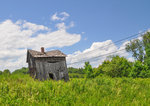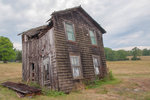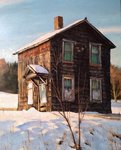Memories are powerful. They can be dredged up by certain sounds and smells, and of course, sights—instantly transporting us to a different time.
Such is the case of the old toll house in …
Stay informed about your community and support local independent journalism.
Subscribe to The River Reporter today. click here
This item is available in full to subscribers.
Please log in to continueNeed an account?
|





In my humble opinion
Memories are powerful. They can be dredged up by certain sounds and smells, and of course, sights—instantly transporting us to a different time.
Such is the case of the old toll house in Bethel, NY, which, as I now know, was never a toll house at all.
The building has stood as a roadside landmark in Sullivan County for as long as I can recall. “A few miles east of the old toll house; turn right at my road,” I’d say to friends visiting from afar. “You can’t miss it,” I’d add. “The tiny little shingled house stands out as the only structure in a huge field. It’s legendary.”
Years ago, Sullivan County Historian John Conway corrected me online, informing me that the building was never a toll house at all, and that folks for miles around were misinformed. “Are you sure?” I asked more than once. “People around these parts think it is, including me.”
Now, as time has begun to seriously take its toll on the scaled-down structure, the online chatter and photos are popping up all over social media. Even local artist Jay Brooks has painted the place on more than a few occasions, so I decided to delve deeper into how the rumors began.
I discovered a blurb with a photo in the Sullivan County Democrat, dated November 2, 1978, and penned by former Bethel town historian Bert Feldman.
“This tiny dwelling,” Feldman wrote, “stands vacant at the corner of Route 17B and Pucky Huddle Road. The last survivor of a number of houses constructed for the toll collectors on the Monticello-Jefferson Turnpike, the building served as a private home until a few years back.”
I sent that old clipping to John, asking for his thoughts on the 44-year-old caption.
“Many people swear the building in question is an old toll house on the long-defunct Newburgh-Cochecton Turnpike, but I am reasonably certain that is not the case,” Conway wrote in response. “Yet the argument persists.
“The question of whether or not this building was a toll house was a controversial topic even decades ago, long before I became County Historian in 1993… and apparently it continues to be.”
Conway continued, “The late Bert Feldman, my friend and former Bethel Town Historian insisted it was a toll house, but as much as I respected Bert, I was well aware of his penchant, and often chastised him for it… of never letting the facts get in the way of a good story. He could never produce any proof for his claim.”
Another Bethel Town Historian, Bea Schoch, told Conway repeatedly over the years that she had documentation that it was “never a toll house, but at one time was a weigh station.”
“But I never actually saw the documentation [for that],” John stated. “Bea said it was moved to its present location from farther down Pucky Huddle Road sometime after the turnpike closed, and if that is the case, then obviously it couldn’t have been a toll house.
“And by the way,” he wrote, “toll houses on the Newburgh-Cochecton were most often simply private homes where the owner had been designated or contracted with to keep the gate and collect the money. It might not show up in any property records that it was or was not a toll house. Taking that all into account, my official response to inquiries about the house has always been that there is a difference of opinion with no concluding evidence one way or the other, but what evidence exists suggests that it was not a toll house.”
As I perused the avalanche of online comments, a few stood out. In response to a photo posted by gal-pal Eileen Hennessy on social media, with the words “it’s going” attached, folks had comments.
“Were it not for the chimney, it would have been gone long ago,” one wrote.
Another chimed in with “I’ve been watching this place lean for years. Looks like this may be its final year.”
As one who balks at change and prefers the impossible—that time would simply stand still—I continued to scroll through comments on a variety of friends’ Facebook pages, agreeing that this will likely be the last winter for the place that is near and dear to so many.
“So sad… I always look for that little house,” someone wrote.
Another simply said, “I’ve always loved this lone small building.”
“I believe that this is the last Toll House remaining in Sullivan County when Route 17B was a turnpike,” yet another stated online. “John Conway, our County Historian, can add more details to the history of the structure.”
And so he has, dear reader, so he has.
“I will miss this landmark,” a friend lamented, while posting pics of her own.
Apparently, I’m not alone, and that (IMHO) makes the memory even more precious.
My advice? Take a picture—it’ll last longer.
For more information from the public records on the “Toll House” (“It’s not a toll house!”) and its origins, contact Bethel Town Clerk Rita Sheehan at bethelclerk@hvc.rr.com.
Related stories

Comments
No comments on this item Please log in to comment by clicking here